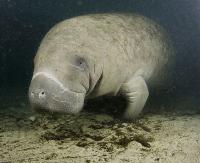 When I was in high school in Florida in the 70s, the question was not “will the manatees become extinct?” but “how fast?” The manatees appeared to be doomed by a loss of habitat, pollution, slow birth rates and being run over by powerboats. By the late 1960s, only a few hundred West Indian manatees remained in Florida coastal waters. Manatees appeared sure to follow their cousin, Steller’s sea cow, which was hunted to extinction in the late 1700s. Now remarkably, almost fifty years later, manatees have come swimming slowly back from the brink.
When I was in high school in Florida in the 70s, the question was not “will the manatees become extinct?” but “how fast?” The manatees appeared to be doomed by a loss of habitat, pollution, slow birth rates and being run over by powerboats. By the late 1960s, only a few hundred West Indian manatees remained in Florida coastal waters. Manatees appeared sure to follow their cousin, Steller’s sea cow, which was hunted to extinction in the late 1700s. Now remarkably, almost fifty years later, manatees have come swimming slowly back from the brink.
Today there are estimated to be at least 13,000 manatees, with more than 6,500 in the southeastern United States and Puerto Rico. That is definitely the good news. What comes next may or may not be good news. The U.S. Fish and Wildlife Service has proposed to remove the West Indian manatee from the endangered species list and reclassify it as “threatened” after “significant improvements” in its population and habitat conditions.
“The manatee’s recovery is incredibly encouraging and a great testament to the conservation actions of many,” Cindy Dohner, the Southeast regional director, said in a news release Thursday. “Today’s proposal is not only about recognizing this progress, but it’s also about recommitting ourselves to ensuring the manatee’s long-term success and recovery.”
The good news is that the change of designation will not very much. The West Indian manatee had been protected under the Endangered Species Act, which defines an endangered species as one in danger of extinction. A threatened species is one that is likely to become endangered within the foreseeable future. Manatees also remain protected under the Marine Mammal Protection Act and the Florida Manatee Sanctuary Act.
The concern is that the groups of developers and boat operators are pushing for a relaxation of restrictions on waterfront development and boat speeds, which are specifically the protections which helped the manatees recover. The new classification, if approved, will not take effect until 2017. At least so far, regulated boat speed requirements and habitat protection will not be impacted by the change in classification.
“The manatee is one of the most charismatic and instantly recognizable species,” said Michael Bean, principal deputy assistant secretary for Fish and Wildlife and Parks at the Department of the Interior.
“It’s hard to imagine the waters of Florida without them, but that was the reality we were facing before manatees were listed under the Endangered Species Act. While there is still more work to be done to fully recover manatee populations, their numbers are climbing and the threats to the species’ survival are being reduced.”

Your first sentence was really interesting to me. Here you were, a guy from Florida in the 70’s wondering when they’ll be extinct.
In elementary school in the late 80’s in Iowa I always thought of manatees as endangered but probably something we would save. Then as I grew up I heard more and more about certain areas where boats weren’t allowed because of manatees.
So I guess in ten years’ time, we went from your perspective to the first one I remember: manatees were probably going to be okay, a feeling that reached as far as Iowa.
Good job humans.